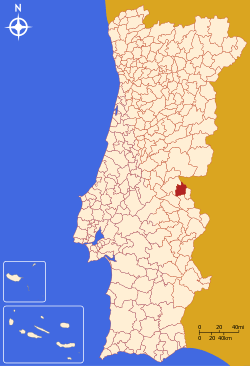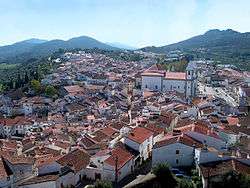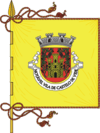Castelo de Vide
| Castelo de Vide | |||
|---|---|---|---|
| Municipality | |||
|
A view of the hilttop seat of the municipality of Castelo de Vide | |||
| |||
 | |||
| Coordinates: 39°20′N 7°31′W / 39.333°N 7.517°WCoordinates: 39°20′N 7°31′W / 39.333°N 7.517°W | |||
| Country |
| ||
| Region | Alentejo | ||
| Subregion | Alto Alentejo | ||
| Intermunic. comm. | Alto Alentejo | ||
| District | Portalegre | ||
| Parishes | 4 | ||
| Government | |||
| • President | António Ribeiro (PSD) | ||
| Area | |||
| • Total | 264.91 km2 (102.28 sq mi) | ||
| Population (2011) | |||
| • Total | 3,407 | ||
| • Density | 13/km2 (33/sq mi) | ||
| Time zone | WET/WEST (UTC+0/+1) | ||
| Website | http://www.cm-castelo-vide.pt | ||
Castelo de Vide (Portuguese pronunciation: [kɐʃˈtɛlu ðɨ ˈvið(ɨ)]) is a municipality in Portugal, with a population of 3,407 inhabitants in 2011,[1] in an area of 264.91 square kilometres (102.28 sq mi).[2]
History
_(4532598860).jpg)
It is unclear when the first settlers occupied the territory of Castelo de Vide, although archaeologists suggest that the decision to occupy the land, came from the morphology of the soil and from a territorial strategy to occupy and conquered lands.[3] The establishment of a fortification helped to fix a new population to the territory and, at the same, defend the nascent colony.[3]
Writing in 1299, Rui de Pina stated that Castelo de Vide remained a weak stronghold, as he wrote "lugar etã mais chão q forte" (the locality is more place then strong).[3] Afonso Sanches, son of king Afonso III, began to rebuild the walls, and his brother, king Denis continued the task, but it was ultimately completed during the reign of Afonso IV, sometime in the 14th century.[3] These changes improved the defensive conditions of the stronghold, including moving a well into the interior and a new line of walls to protect the citadel and the houses outside the original walls. A tower keep was, also, constructed that was even with the southern walls, in order to better defend the southern passage.[3] All these improvements came to ahead with the conflicts with Castille, when siege machine were used. A strategic border fortress, it was acquired in 1276 when Castelo de Vide became its own municipality. Until this time, the territory's settlements were part of Marvão.[3]
Slowly, throughout the 14th century, the settlement expanded outside the castle walls.[3] The southern flanks, with good southerly exposure and gentle slope, allowed easy settlement, while the northern and western exposures were expanded later, due to wind and steep cliff faces.[3] The growth of the settlement occurred along the main road leading to the castle, and followed the expansion of religious buildings outside the walls.[3] This road bisected two sides of the hill and one was occupied by a Jewish Quarter, inhabited by Jews expelled from Castile and Aragon.[3]
Many of the perceptions of the town came from the 16th century drawings of Duarte d'Armas, who drew representations of the town.[3] At that time, the settlement was dedicated to agriculture (cultivating vineyard, cotton, olives, fruits and cereals) and raising cattle, while watermills were constructed to mill along the ravines in Vide and Nisa.[3] At the end of the 15th century, and beginning of the 16th century, the wool industry obtained an importance in the region, at the end of King John III reign. This importance resulted in its inhabitants began to be referred to as the Cardadores; there were 885 inhabitants in 1527, but rose to 1400 by 1572 and 1600 by 1603. This growth was based in the growth in agricultural production, the textile industry and commerce with Spain.[3]
The new foral (charter), issued by King Manuel I in 1512, established new laws for public spaces and organized the towns specific limits.[3]
Geography
The municipality is located by the Serra de São Mamede in Portalegre District.
| Population of Castelo de Vide Municipality (1801 – 2011) | ||||||||
|---|---|---|---|---|---|---|---|---|
| 1801 | 1849 | 1900 | 1930 | 1960 | 1981 | 1991 | 2001 | 2011 |
| 7 006 | 6 031 | 6 614 | 6 837 | 6 538 | 4 187 | 4 145 | 3 872 | 3 407 |
Administratively, the municipality is divided into 4 civil parishes (freguesias):[4]
- Nossa Senhora da Graça de Póvoa e Meadas
- Santa Maria da Devesa
- Santiago Maior
- São João Baptista
References
- Notes
- ↑ Instituto Nacional de Estatística
- ↑ Direção-Geral do Território
- 1 2 3 4 5 6 7 8 9 10 11 12 13 14 Câmara Municipal, ed. (2013). "Brief History" (in Portuguese). Castelo de Vide, Portugal: Câmara Municipal de Castelo de Vide. Retrieved 25 January 2015.
- ↑ Diário da República. "Law nr. 11-A/2013, page 552 35" (pdf) (in Portuguese). Retrieved 20 July 2014.
- Sources
- Quintanilha, Susana Maria de; Bicho, Mendonça Mendes (December 1999), A Judiaria de Castelo de Vide (contributos para o seu estudo na óptica da conservação do património urbano) (in Portuguese), Évora, Portugal
- Jorge, Ana Rita Santos (June 1991), The Old "Burgo" of Castelo de Vide - Portugal - Safeguard and Conservation (in Portuguese)
- Bica, José (July 2003), Secção de Arqueologia da Câmara Municipal de Castelo de Vide (in Portuguese)
External links
- Town Hall official website
- Some photographs of Castelo de Vide, taken in 2007
- 33 photos of Castelo de Vide


